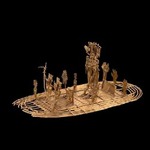 Traveling, to me, usually involves looking at the art a country has made and accumulated. Of course, one knows in advance that you don’t really go to Colombia, my summer vacation destination, to discover world-class art. But every country has something.
Traveling, to me, usually involves looking at the art a country has made and accumulated. Of course, one knows in advance that you don’t really go to Colombia, my summer vacation destination, to discover world-class art. But every country has something.
Let’s start with Colombia’s bright spots: both Bogota and Cartagena (the two cities I visited) have a Museo del Oro, both owned by Colombia’s central bank, Banco de la Republica. The main one, in Bogota, was remodeled in 2008, and tells an excellent tale of gold in Colombia’s regions. Along with the artifact-filled vitrines are an occasional video. There’s an “experience” at the end, called the Offering, where people are directed to a meeting area. A wall suddenly encloses the area, and visitors see a sound and light show.
I liked the artifacts — like the raft above — much better. There are also wonderful study rooms, where people can use either computers or books to learn more. Clearly, the varied experiences were designed to offer something for everyone. Late on a Tuesday afternoon, Bogota’s Museo del Oro was nicely full but not crowded.
The branch in Cartagena, much smaller, contains artifacts from the area, mostly, including this funerary urn, at left.
(Apologies for the glass glare.)
Bogota has a museum of colonial art, which proved very disappointing. There’s little in it, and what’s there is not the best quality. I was the only person in the galleries one weekday morning.
The city also has a museum of modern art, but it is a kunsthalle, and was closed for reinstallation while I was there.
On to the National Museum, which is a combined history-portrait-art museum. The building (above), designed as a panopticon and used as a jail, looks like a fortress, but (after what guidebooks say was an extensive reconstruction) actually works well as a museum. The long hallways function as galleries for exhibits about archaeology, the colonial era, the struggle for independence, national portraits, costumes, and even mummies.
One floor is dedicated to art of the 20th century, including many works by — guess who? Fernando Botero. Botero seems to be a beloved figure in Colombia and, based on the art I saw, the only artist there who has developed a unique style.
What I liked about seeing some of his works here, though, is that some are by Botero before he became Botero. You can see him working through other styles, other artists. Here’s an example (again, apologies for the picture quality). It’s called Contrapunto, from 1957.
More about Botero, and the Bank, in another post.
Photo Credits: Courtesy Museum del Oro (top);  © Judith H. Dobrzynski (bottom three, all rights reserved)
© Judith H. Dobrzynski (bottom three, all rights reserved)
